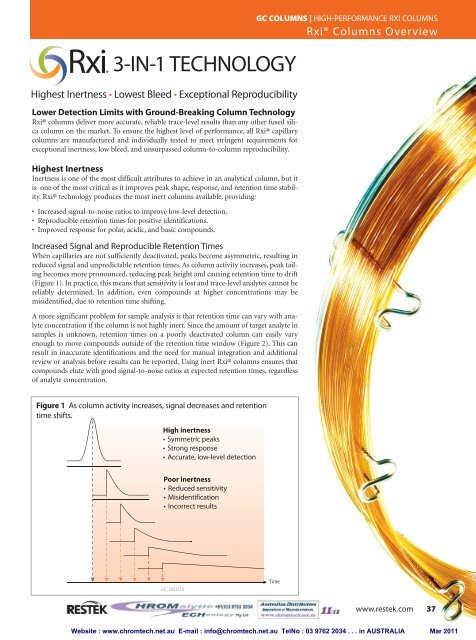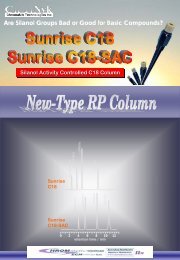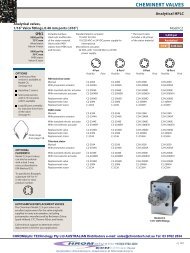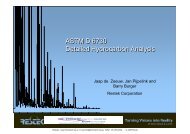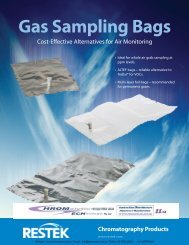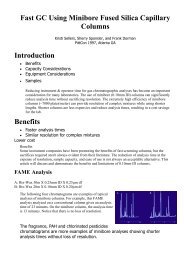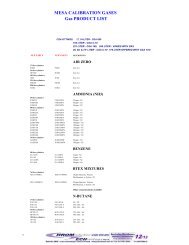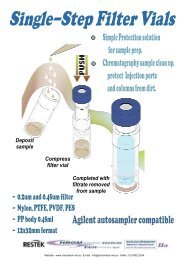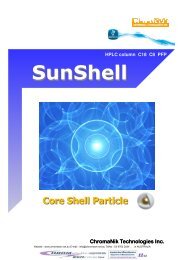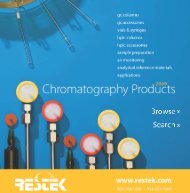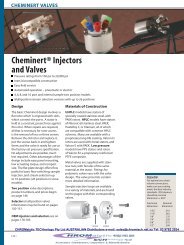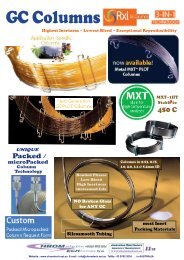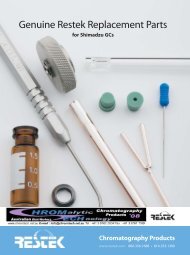gc columns
gc columns
gc columns
- No tags were found...
You also want an ePaper? Increase the reach of your titles
YUMPU automatically turns print PDFs into web optimized ePapers that Google loves.
3-IN-1 TECHNOLOGYHighest Inertness • Lowest Bleed • Exceptional ReproducibilityLower Detection Limits with Ground-Breaking Column TechnologyRxi® <strong>columns</strong> deliver more accurate, reliable trace-level results than any other fused silicacolumn on the market. To ensure the highest level of performance, all Rxi® capillary<strong>columns</strong> are manufactured and individually tested to meet stringent requirements forexceptional inertness, low bleed, and unsurpassed column-to-column reproducibility.Highest InertnessInertness is one of the most difficult attributes to achieve in an analytical column, but itis one of the most critical as it improves peak shape, response, and retention time stability.Rxi® technology produces the most inert <strong>columns</strong> available, providing:• Increased signal-to-noise ratios to improve low-level detection.• Reproducible retention times for positive identifications.• Improved response for polar, acidic, and basic compounds.Increased Signal and Reproducible Retention TimesWhen capillaries are not sufficiently deactivated, peaks become asymmetric, resulting inreduced signal and unpredictable retention times. As column activity increases, peak tailingbecomes more pronounced, reducing peak height and causing retention time to drift(Figure 1). In practice, this means that sensitivity is lost and trace-level analytes cannot bereliably determined. In addition, even compounds at higher concentrations may bemisidentified, due to retention time shifting.A more significant problem for sample analysis is that retention time can vary with analyteconcentration if the column is not highly inert. Since the amount of target analyte insamples is unknown, retention times on a poorly deactivated column can easily varyenough to move compounds outside of the retention time window (Figure 2). This canresult in inaccurate identifications and the need for manual integration and additionalreview or analysis before results can be reported. Using inert Rxi® <strong>columns</strong> ensures thatcompounds elute with good signal-to-noise ratios at expected retention times, regardlessof analyte concentration.GC COLUMNS | HIGH-PERFORMANCE RXI COLUMNSRxi® Columns OverviewFigure 1 As column activity increases, signal decreases and retentiontime shifts.High inertness• Symmetric peaks• Strong response• Accurate, low-level detectionPoor inertness• Reduced sensitivity• Misidentification• Incorrect resultsGC_EX01116Timewww.restek.com 37Website : www.chromtech.net.au E-mail : info@chromtech.net.au TelNo : 03 9762 2034 . . . in AUSTRALIA Mar 2011


